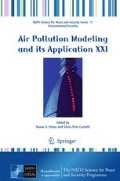Abstract
The influence of the approach flow direction on contaminant spreading and ventilation within an intersection in an idealised symmetrical urban area was investigated in this study. Advective horizontal and vertical scalar fluxes are computed from measured data for five flow directions. The highest advective contaminant fluxes are measured in the bottom parts of street-canyons. The important role of the vertical turbulent scalar flux in ventilation of intersection is expected. Quadrant analysis of vertical flux of longitudinal momentum is used to determine a domination of sweep or ejection events above the intersection.
Access this chapter
Tax calculation will be finalised at checkout
Purchases are for personal use only
References
Belcher ES (2005) Mixing and transport in urban areas. Philos Trans R Soc A 363:2947–2968
Britter RE, Hanna SR (2003) Flow and dispersion in urban areas. Annu Rev Fluid Mech 35:469–496
Kellnerová R (2009) Quadrant analysis of boundary layer above pitched and flat roofs. Acta Tech 54:401–413
Robins A (2009) Short range dispersion in urban areas. NCAS Urban Meteorology Workshop, Reading
Robins A, Savory E, Scaperdas A, Grigoriadis D (2002) Spatial variability and Source-receptor relations at a street intersection. Water Air Soil Pollut 2:381–393
Townsend AA (1976) A structure of turbulent shear flow. Cambridge University Press, New York
Wang X, McNamara KF (2007) Effects of street orientation on dispersion at or near urban street intersections. J Wind Eng Ind Aerodyn 95:1526–1540
Acknowledgments
Authors kindly thank Charles University for support by grant GAUK No. 136609 (115-10/259266), the Ministry of Education, Sports and Youth of the Czech Republic for support by AVOZ20760514 and support of the Academy of Sciences of the Czech Republic.
Author information
Authors and Affiliations
Corresponding author
Editor information
Editors and Affiliations
Rights and permissions
Copyright information
© 2011 Springer Science+Business Media B.V.
About this paper
Cite this paper
Kukačka, L., Kellnerová, R., Jurčáková, K., Jaňour, Z. (2011). Analysis of Scalar Fluxes and Flow Within Modelled Intersection Depending on the Approach Flow Direction. In: Steyn, D., Trini Castelli, S. (eds) Air Pollution Modeling and its Application XXI. NATO Science for Peace and Security Series C: Environmental Security. Springer, Dordrecht. https://doi.org/10.1007/978-94-007-1359-8_20
Download citation
DOI: https://doi.org/10.1007/978-94-007-1359-8_20
Published:
Publisher Name: Springer, Dordrecht
Print ISBN: 978-94-007-1358-1
Online ISBN: 978-94-007-1359-8
eBook Packages: Earth and Environmental ScienceEarth and Environmental Science (R0)

